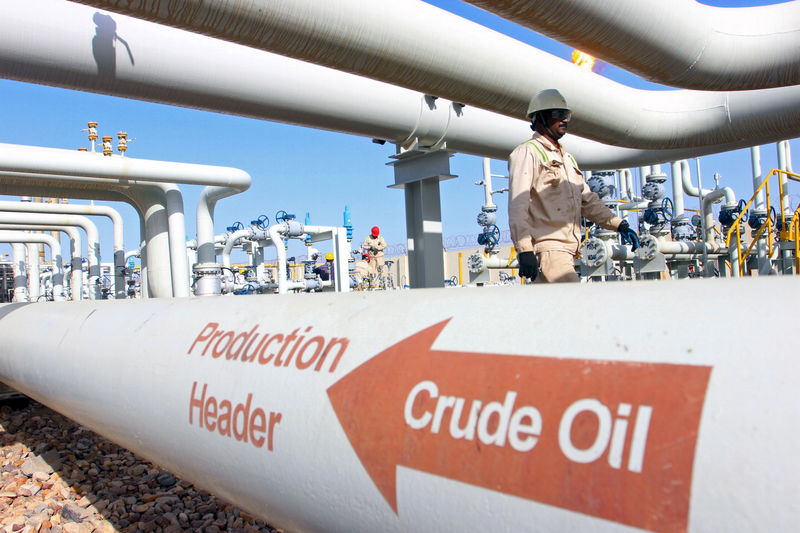* Saudi Arabia says sees need for 1 mln bpd cut in output
* Trump hopes OPEC won't cut output, says prices should be lower
* OPEC producers mull supply reductions for 2019
* OPEC reacts to 20 pct price fall since early October
* U.S. oil output, storage & drilling: https://tmsnrt.rs/2DhQOCB (Updates with settlement prices, recasts first paragraph, adds post-settlement trading)
By Jessica Resnick-Ault
NEW YORK, Nov 12 (Reuters) - U.S. crude prices fell for the 11th consecutive session, the most on record since the contract began trading, retreating from a rally early in the session as U.S. President Donald Trump said he hoped there would be no oil output reductions.
Trump's comment followed remarks from Saudi Arabia's energy minister saying OPEC was considering cutting supply next year, citing softening demand. Saudi Arabia has expressed concerns that U.S. sanctions have removed less oil from the market than expected. benchmark West Texas Intermediate crude CLc1 fell 26 cents a barrel to settle at $59.93. The fall marked the 11th consecutive daily decline, the most since the contract began trading, according to data from CME Group (NASDAQ:CME). The contract continued to drop in post-settlement trading, falling $1.48 to $58.71 a barrel by 3:34 p.m. EST (1834 GMT).
Brent crude futures LCOc1 reversed course late in the session, settling down 6 cents at $70.12 a barrel. Brent also traded lower in post-settlement activity, dropping $1.13 to $69.05 a barrel.
"Hopefully, Saudi Arabia and OPEC will not be cutting oil production," Trump wrote on Twitter. "Oil prices should be much lower based on supply!" U.S. crude turned negative and extended losses after the tweet.
Oil prices had strengthened early in the session, after Saudi Arabia said the Organization of the Petroleum Exporting Countries and its partners believed demand was softening enough to warrant an output cut of 1 million barrels per day next year.
Saudi Energy Minister Khalid al-Falih said OPEC and its allies agree that technical analysis shows a need to cut oil supply next year by around 1 million bpd from October levels. Arabia, the world's largest oil exporter, said on Sunday it would cut its shipments by half a million bpd in December due to seasonal lower demand. kind of back to square one: It must feel like November 2016 to them, a lot," said John Kilduff, a partner at Again Capital Management in New York, referring to the time period when OPEC and its allies agreed to initiate production cuts. "The Saudis and Russians, especially, rushed production to market to offset losses that aren't materializing."
The market had anticipated that exports from OPEC member Iran would fall precipitously following the institution of U.S. sanctions in November. However, the U.S. has granted waivers to certain major importers of Iranian crude, diminishing the expected cuts. and the International Energy Agency release their respective monthly reports on the outlook for oil supply and demand later this week. OPEC/M IEA/M
Oil prices have fallen around 20 percent in the last month, hit by an increase in global supply and the threat of a slowdown in demand, especially from customers whose currencies have weakened against the dollar and eroded their purchasing power.
Output from the world's top oil producers Russia, the United States and Saudi Arabia has risen by 1.05 million bpd in the last three months, based on official output figures. PRODN-SA C-RU-OUT C-OUT-T-EIA
This has left OPEC scrambling to adjust its own output, which, at around 33.3 million bpd, accounts for roughly a third of global supply.
An official from group member Kuwait said on Monday major oil exporters had over the weekend "discussed a proposal for some kind of cut in (crude) supply next year", although the official did not provide any detail. of OPEC's biggest problems is the surge in U.S. output.
"One thing that is abundantly clear, OPEC is in for a shale shocker as U.S. crude production increased to a record 11.6 million barrels per day and will cross the 12 million threshold next year," said Stephen Innes, head of trading for Asia-Pacific at futures brokerage Oanda in Singapore.
<^^^^^^^^^^^^^^^^^^^^^^^^^^^^^^^^^^^^^^^^^^^^^^^^^^^^^^^^^^^ GRAPHIC: U.S. oil production, drilling & storage levels
https://tmsnrt.rs/2QCiGoO
^^^^^^^^^^^^^^^^^^^^^^^^^^^^^^^^^^^^^^^^^^^^^^^^^^^^^^^^^^^>
